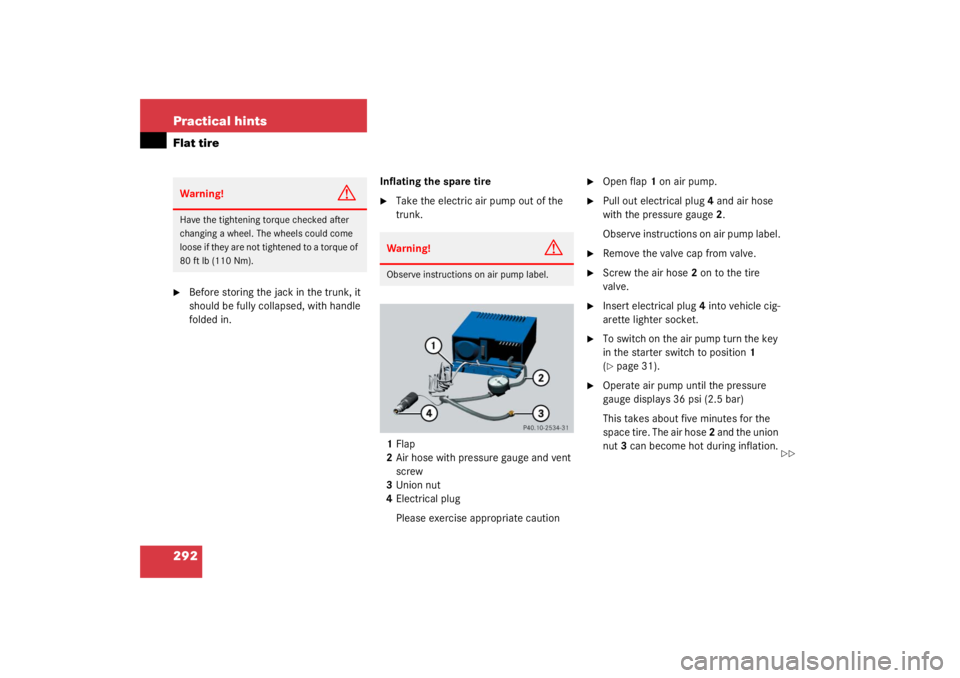Page 235 of 356

235
Operation
Tires and wheels
Tire pressure changes by approximately
1.5 psi (0.1 bar) per 18°F (10°C) of air
temperature change. Keep this in mind
when checking tire pressure where the
temperature is different from the outside
temperature.
Tire temperature and tire pressure are also
increased while driving, depending on the
driving speed and the tire load.
Check the spare tire periodically for condi-
tion and inflation. Spare tires will age and
become worn over time even if never used,
and thus should be inspected and replaced
when necessary.
Rotating wheels
On vehicles with the same wheel size all
around, wheels can be rotated every 3000
to 6000 miles (5 000 to 10 000 km), or sooner if necessary, according to the de-
gree of tire wear. The same direction of tire
rotation must be retained.
Rotate the wheels before the characteris-
tic tire wear pattern becomes visible
(shoulder wear on front wheels and tread
center wear on rear wheels).
Thoroughly clean the inner side of the
wheels after each rotation. Check and en-
sure proper tire inflation pressure.
Warning!
G
Follow recommended inflation pressures.
Do not overinflate tires. Overinflating tires
can result in sudden de
flation (blowout) be-
cause they are more likely to become punc-
tured or damaged by road debris, potholes
etc.
Do not underinflate tires. Underinflated tires
wear unevenly, adversely affect handling
and fuel economy, and are more likely to fail
from being overheated.
Do not overload the tires by exceeding the
specified vehicle capacity weight (as indicat-
ed by the label on the pillar in the driver’s
door opening). Overloading the tires can
overheat them, possibly causing a blowout.Warning!
G
Rotate front and rear wheels only if they are
of the same size.
Warning!
G
Have the tightening torque checked after
changing a wheel. Wheels could become
loose if not tightened with a torque of
80 ft.lb. (110 Nm).
Use only genuine Mercedes-Benz wheel
bolts specified for your vehicle's rims.
Page 291 of 356

291
Practical hints
Flat tire
�
Unscrew the alignment bolt, install last
wheel bolt and tighten slightly.
Lowering the vehicle
�
Lower vehicle by turning crank coun-
terclockwise until vehicle is resting ful-
ly on its own weight.
�
Remove the jack.
1-5 Wheel bolts
�
Tighten the five wheel bolts evenly, fol-
lowing the diagonal sequence illustrat-
ed (1 to 5), until all bolts are tight.
Observe a tightening torque of 80 ft lb
(110 Nm).
!To avoid paint damage, place wheel flat
against hub and hold it there while in-
stalling first wheel bolt.Warning!
G
Always replace wheel bolts that are dam-
aged or rusted.
Never apply oil or grease to wheel bolts.
Damaged wheel hub threads should be re-
paired immediately. Do not continue to drive
under these circumstances! Contact an au-
thorized Mercedes-Benz Center or call
Roadside Assistance.
Incorrect mounting bolts or improperly
tightened mounting bolts can cause the
wheel to come off. This could cause an acci-
dent. Be sure to use the correct mounting
bolts.
Warning!
G
Use only genuine equipment
Mercedes-Benz wheel bolts. They are identi-
fied by the Mercedes star. Other wheel bolts
may come loose.
Do not tighten the wheel bolts when the ve-
hicle is raised. Otherwise the vehicle could
tip over.
��
Page 292 of 356

292 Practical hintsFlat tire�
Before storing the jack in the trunk, it
should be fully collapsed, with handle
folded in.Inflating the spare tire
�
Take the electric air pump out of the
trunk.
1 Flap
2 Air hose with pressure gauge and vent
screw
3 Union nut
4 Electrical plug
Please exercise appropriate caution
�
Open flap 1 on air pump.
�
Pull out electrical plug 4 and air hose
with the pressure gauge 2.
Observe instructions on air pump label.
�
Remove the valve cap from valve.
�
Screw the air hose 2 on to the tire
valve.
�
Insert electrical plug 4 into vehicle cig-
arette lighter socket.
�
To switch on the air pump turn the key
in the starter switch to position 1
(�page 31).
�
Operate air pump until the pressure
gauge displays 36 psi (2.5 bar)
This takes about five minutes for the
space tire. The air hose 2 and the union
nut 3 can become hot during inflation.
Warning!
G
Have the tightening torque checked after
changing a wheel. The wheels could come
loose if they are not tightened to a torque of
80 ft lb (110 Nm).
Warning!
G
Observe instructions on air pump label.
��
Page 310 of 356
310 Technical dataEngine
EngineModel
C 230 Kompressor (203.740)
1
1The quoted data apply only to the standard vehicle. See an authorized Mercedes-Benz Center for the corresponding data of all special bodies and special equipment.
C 320 (203.764)
1
Engine
271
112
Mode of operation
4-stroke engine, gasoline injection
4-stroke engine, gasoline injection
No. of cylinders
4
6
Bore
3.23 in (82.00 mm)
3.54 in (89.90 mm)
Stroke
3.35 in (85.00 mm)
3.3 in (84.00 mm)
Total piston displacement
109.6 cu.in. (1796 cm
3)
195.2 cu.in. (3199 cm
3)
Compression ratio
8.5:1
10:1
Output acc. to SAE J 1349
189 hp / 5800 rpm
(141 kW / 5800 rpm)
214 hp / 5700 rpm
(160 kW / 5700 rpm)
Maximum torque acc. to SAE J 1349
192ft.lb/3500rpm
(260 Nm / 3500 rpm)
232ft.lb/3000rpm
(310 Nm / 3000 rpm)
Maximum engine speed
6000 rpm
6000 rpm
Firing order
1-3-4-2
1-4-3-6-2-5
Poly-V-belt
7ft 11in (2420mm)
7 ft 10 in (2390 mm)
Page 314 of 356
314 Technical dataElectrical system
Electrical systemModel
C230Kompressor
C320
Generator (alternator)
14 V/120 A
14 V/120 A
Starter motor
12 V/1.1 kW
12 V/1.7 kW
Battery
12V/100 Ah
12V/100 Ah
Spark plugs
Bosch F 6 MPP 332
Bosch F 8 DPP332
NGK PFR 5 R-11
Electrode gap
0.031 in (0.8 mm)
0.039 in (1.0 mm)
Tightening torque
18 – 22 ft.lb (25 - 30 Nm)
15 – 22 ft.lb (20 – 30 Nm)
Page 330 of 356

330 Technical termsPower trainCollective term designating all compo-
nents used to generate and transmit
motive power to the drive axles, includ-
ing
�
engine
�
clutch/torque converter
�
transmission
�
transfer case
�
drive shaft
�
differential
�
axle shafts/axles Poly-V-belt drive
Drives engine-components (alternator,
AC compressor, etc.) from the engine.
Program mode selector switch Used to switch the automatic transmis-
sion between standard operation S and
winter operation W.
Remote Vehicle Diagnostics Transmission of vehicle data and cur-
rent location to the Mercedes-Benz
Customer Assistance Center for sub-
scribers to Tele Aid service.
Restraint systems Seat belts, belt tensioners, airbags and
child restraint systems. As indepen-
dant systems, their protective func-
tions complement one another. RON
(R
esearch O
ctane N
umber)
The Research Octane Number for gaso-
line as determined by a standardized
method. It is an indication of a gaso-
line's ability to resist undesired detona-
tion (knocking). The average of both
the ->MON (Motor Octane Number)
and RON (Research Octane Number) is
posted at the pump, also known as AN-
TI-KNOCK INDEX.
Shift lock When the vehicle is parked, this lock
prevents the transmission selector le-
ver from being moved out of position P
without key turned and brake pedal de-
pressed.
Page 331 of 356

331
Technical terms
SRS
(S
upplemental R
estraint S
ystem)
Seat belts, emergency tensioning de-
vice and airbags. Though independent
systems, they are closely interfaced to
provide effective occupant protection.
Tele Aid* System (T
elematic A
larm I
dentification on D
e-
mand)
The Tele Aid system consists of three
types of response: automatic and man-
ual emergency, roadside assistance
and information. Tele Aid is initially ac-
tivated by completing a subscriber
agreement and placing an acquain-
tance call.
The Tele Aid system is operational pro-
viding that the vehicle’s battery is
charged, properly connected, not dam-
aged and cellular and GPS coverage is
available. Tightening torque
Force times lever arm (e.g. a lug
wrench) with which threaded fasteners
such as wheel bolts are tightened.
Tire speed rating Part of tire designation; indicates the
speed range for which a tire is ap-
proved.
Traction Force exerted by the vehicle on the
road via the tires. VIN
(V
ehicle I
dentification N
umber)
The number set by the manufacturer
and placed on the body to uniquely
identify each vehicle produced.
Voice control system* Voice control system for car phones,
portable cell phones and audio sys-
tems (radio, CD, etc.).
Page 352 of 356

352 IndexTelephoneEmergency call 179
Telephone* 24, 200 Answering a call 128
Dialing a number from the phone book 128
Ending a call 128
Hands-free microphone 26
Loading phone book* 128
Messages in display 269
Operating 126
Operation 176
Redialing 129
Temperature Display mode 117
Grades of tires 326
Setting interior temperature 145
Setting units in display 117
Tires 235
Tightening torque 331
Tightening torque (Wheel bolts) 291
Tilt Backrest 33
Head restraint 34
Seat cushion 33 Time
Setting hours 116
Setting minutes 116
Time display Setting 117
Tire inflation pressure Checking 225, 234
Tire speed rating 219, 331
Tire traction 219
Tires 233, 311 Collapsible 328
Consumer information 325
Direction of rotation 234
Driving instructions 218
Retreads 233
Rims and tires 311
Service life 234
Temperature 235
Temperature grades 326
Tread depth 236
Wear pattern 235
Winter 236
Tools 272
Tow-away alarm 25, 79 Arming 79
Disarming 79 Disarming for transport 79
Towing eye bolt (vehicle tool kit) Installing 302
Towing the vehicle 299
Tracking services For stolen vehicle 209
Traction 136, 325, 331
Transmission see Automatic transmission 229
Transmission selector lever 277 Unlocking manually 277
Tread depth (tires) 236
Treadwear 325
Trim panel Opening 304
Trip computer 125
Trip odometer Resetting 103
Trunk Auxiliary fuse box 304
Lighting 101
Trunk lid 85
Trunk lid Closing 86
Emergency release 86
Opening 85